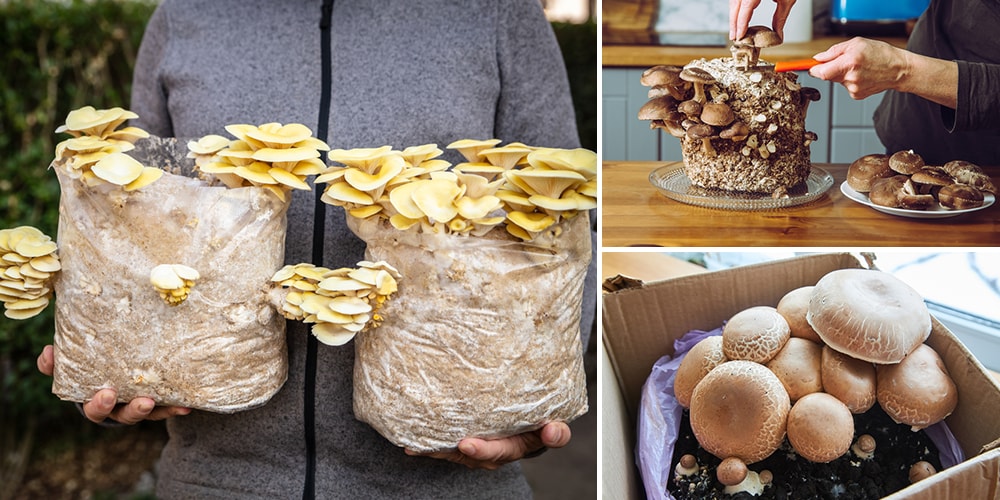
How to Grow Medicinal Mushrooms at Home
It is possible to grow medicinal mushrooms at home and it is not as tedious as you may think. Mushrooms are technically fungi, a reproductive structure of fungi, at least. Granting these organisms thrive in moist places, you may rationalize they have different growing conditions from other plants. But, replicating their conducive environment can make it possible for you to grow, care and harvest medicinal mushrooms even in the comfort of your own home.
Mushrooms are the fruiting body of fungi that grows above the ground. They come in wide forms, identifications and colors. Different mushroom species also serve different purposes.
What Are Medicinal Mushrooms?
Medicinal mushrooms are species that contain bioactive compounds which offer therapeutic properties and healing benefits. Many of them are popularly used as food supplements for treating chronic illnesses.
These types of mushrooms have different healing attributes such as anti-inflammatory, analgesic, anti-aging and immune- boosting, among others. Many medicinal mushrooms possess beneficial properties for managing degenerative diseases.
Types of Medicinal Mushrooms
Lion’s Mane
Lion’s Mane (Hericium erinaceus) is not your typical umbrella-like mushroom. It has a unique pom-pom appearance. They have teeth or spines that cascade downward with a shaggy look that resembles a lion’s mane, white instead of yellow-gold.
This unique mushroom is considered one of the best sources of compounds that boost the brain, nerves and immune health. Lion’s mane has a nootropic property that improves logical thinking, concentration and memory. Lion’s mane is effective against many degenerative brain conditions like Alzheimer’s disease, ADHD, anxiety and autism.

In folk tradition, eating lion’s mane is said to give a person the nerves of steel and the memory of a lion. Aside from its brain-promoting properties, lion’s mane also helps decrease inflammation, stimulate the immune system and cure diabetes.
Lion’s mane is widely available in herbal supplement form and rarely in its dried form. Growing your own bag of lion’s mane gives better access to its natural healing powers. You can steam the fresh stalk and consume its water, or dry it and steep it into tea, or make powerful tinctures.
Reishi
Reishi (Ganoderma lucidum), simply known as Ganoderma or Lingzhi, is infused in many herbal supplements, including herbal coffee. Reishi is rich in triterpenes, a ganoderic acid that suppresses histamine production and is useful for treating asthma and allergies.
Ganoderma has anti-inflammatory, anti-aging, tonic, immunomodulator and nervine properties. It is also valued in the treatment of liver diseases.
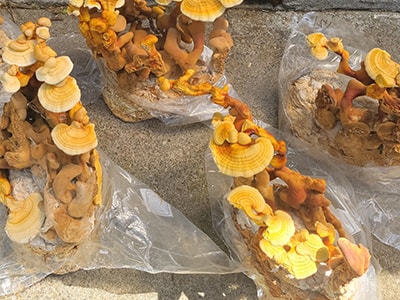
The most potent preparation of reishi is its tincture prepared by infusing it in alcohol. Just soak finely chopped reishi mushrooms in 100-proof vodka, enough to cover them. Let it soak in the alcohol for about a month while shaking regularly.
After at least a month, strain the alcohol and add twice the amount of water as the strained liquid. Add back the mushroom into the liquid and boil until the liquid is halved. Strain the tincture and store it in a cool place where it can stay for two years.
Cordyceps
Cordyceps militaris is a fungus that grows on the larva of insects. Cordyceps supplements are popular among athletes due to their ability to boost stamina and performance. Taking cordyceps largely affects oxygen intake which improves blood circulation and is beneficial for heart health.
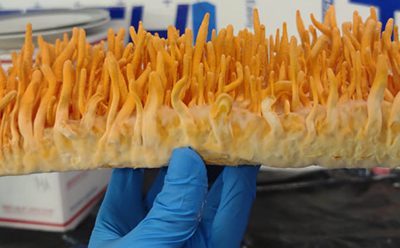 Cordyceps is also the mushroom of choice for improving sexual performance in both men and women.
Cordyceps is also the mushroom of choice for improving sexual performance in both men and women.
They are best taken in supplement form or consumed as food. Powdered cordyceps are mixed into milk or water and taken for various ailments.
Turkey Tail
Turkey tail (Trametes versicolor) is a polypore mushroom that thrives in highly humid places. When growing this mushroom at home, either indoors or outdoors, a high humidity level is important for it to colonize. They are better inoculated into holes of hardwood logs like oak, beech or maple.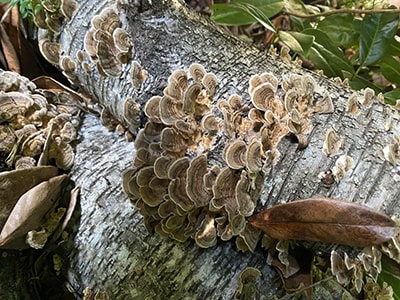
This rosette-shaped mushroom is a medicinal fungus for treating common colds and flu. It is also best for improving gut health and is effective in treating diabetes. Turkey tail is also considered as a potential medicinal mushroom for treating HIV and HPV. It is beneficial for patients undergoing chemotherapy, increasing the chances of cancer survival.
Turkey tail is consumed fresh or cooked. It is prepared as sauté or simmered in stews and broths. There are also turkey tail tinctures, extracts and powders available that you can add to shakes, smoothies, or meals.
Portobello
Portobello (Agaricus bisporus) is a pretty common mushroom in supermarkets, either dried or in cans. It is also one of the easiest mushrooms you can grow at home in a moist and humid environment. Portobello mushrooms are a handy home remedy for anemia and digestive problems like constipation, bloating and indigestion.
Take this type of mushroom if you need to improve your energy levels. It is rich in riboflavin that helps maintain the nerve, brain and hormone functions. The hormones control the energy, appetite and body temperature which improves the body’s functions.
Shiitake
Shiitake (Lentinus edodes) is also an edible mushroom commonly enjoyed in stir-fries, one-pot dishes or pasta sauces. Shiitake is not only full of nutrients but also brings therapeutic benefits. It has anti-viral, anti-fungal and anti-bacterial properties to deal with seasonal illnesses. Shiitake is also rich in antioxidants that ward off certain types of cancers.
People wanting to lose weight may benefit from shiitake’s fat-reducing components. It has B-glucan and eritadinine that increase satiety and boost metabolic functions. Adding shiitake mushrooms to the diet balances the hormones to improve brain functions and cognitive performance.
Chaga
Chaga (Inonotus obliquus) is a parasitic black fungus that thrives in birch trees. Among the different types of mushrooms, Chaga is quite difficult to grow because they only thrive in living birch trees. If you have trees in your area, you can inoculate the spores in it for the mushroom to successfully colonize.
Chaga looks like a lumpy mass of black charcoal, almost unidentifiable as a mushroom. Strange-looking it may seem, Chaga is edible and full of effective and promising health benefits. It shares many common properties with medicinal mushrooms such as delaying aging, lowering cholesterol and increasing physical endurance. Chaga is useful against cancer, diabetes, blood clots and liver diseases. It is also beneficial for brain and cardiovascular health. You can use Chaga just as you would with other edible mushrooms. Or, you can make a tea out of its chunks to extract its bioactive compounds more efficiently.
Here is a complete guide to edible mushrooms, plants, berries and poisonous lookalikes.
How To Grow Medicinal Mushrooms
You may already stumble upon “mushroom growing kits” sold in some online stores or distributors within your area. These are the fruiting bags that already include the mushroom spawn and its growing medium. You may also buy the spawn separately and prepare its growing media or substrate yourself. Some are available as plugs or dowels impregnated with mushroom spores.
Materials
- Mushroom spore or spawn in a syringe
- Hardwood pellets
- Oat or bran
- Fruiting bags, containers or logs
- Water
- Measuring cup
- Bowl
- Pressure cooker
Procedure
Step 1
- Prepare the substrate of growing media. You can also find the appropriate substrate for a certain mushroom species in the product description when buying the spores.
- Combine 5 cups of pellets and six cups of water.
- Soak them for 30 minutes until the mixture has a sawdust texture.
- Add 1 ¼ cups of bran and mix well. Make sure that the substrate is neither too wet nor too dry. A few drops of water should come out if you squeeze it but it should not be runny.
- Put the mixture in the fruiting bag, removing as much air as possible while you do.
Step 2
- Sterilize the substrate to kill spores and other organisms in the growing media to prevent contamination.
- Submerge the bag in a pressure cooker and let it boil for 2 hours and 30 minutes at 15 PSI.
- Remove from the cooker and allow it to cool completely, at least 8 hours on estimate.
Step 3
- Inoculate the mushroom spawn into the fruiting bags.
- Sterilize your work surfaces and disinfect your hands before working to avoid contamination.
- Spray the surface of the bag where you will inject the syringe needle with a disinfectant spray like Bacillol. Let the spray stay for about 30 seconds before wiping it down with clean kitchen paper.
- Shake the syringe and inject it into the bag. For a small 2.5 liter bag, use about 10 to 20 ml of the mushroom spore. Use 2 to 3 mL in large 4.5 L bags.
- Close and seal the bag including the inoculation area.
- Shake the bag carefully to distribute the spores evenly in the bag.
Step 4
- Incubate the bags.
- Place the fruiting bags in a dark and warm area with a temperature between 20-24⁰C (68-75⁰F).
- The colonization period of the spawn depends on the species, temperature and humidity. Reishi can colonize the bag in 10 to 14 days. Other strains like the lion’s mane can take up to 21 days to fully colonize the fruiting bag.
- You can harvest mushrooms in their different stages of maturity. Most mushrooms are mature and due for harvest when the edges shrink and the heads are firm and dense.

Growing Mushrooms in Logs
Logs are the most viable growing place for mushrooms and also the easiest to maintain. You can purchase spores in dowels and insert them in drilled holes in the logs. Choose healthy hardwoods for it – and not conifers – with a diameter of at least 10 cm and about 45 cm long. (Reishi may do well in conifers, though, preferably in hemlocks.)
Some mushroom growing kits may come with sealing wax. Use it as directed after inserting the impregnated dowels or sawdust with spores into the log. Put the log in a shady spot, one end on the ground and the other popped up to keep the moisture.
Takeaway
Growing mushrooms is not a conventional thing for gardeners. But it is becoming more popular nowadays. Depending on your area, you may find local suppliers selling inoculated fruiting bags you can care for until harvest. Though fruiting bags are convenient, growing them in logs proves to be more successful because it simulates their natural environment.
Medicinal mushrooms are a great addition to your herbal medicine cabinet and are safe when taken in food amounts. However, if you have allergies or you’re taking other medications, you may still need to consult a health professional. Medicinal mushrooms possess potent compounds that can interfere with medications and are harmful when consumed excessively.






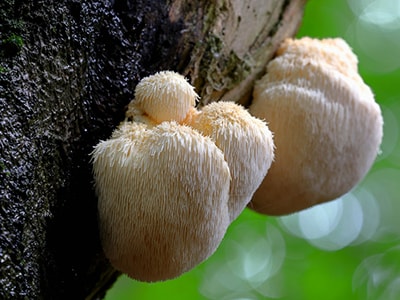
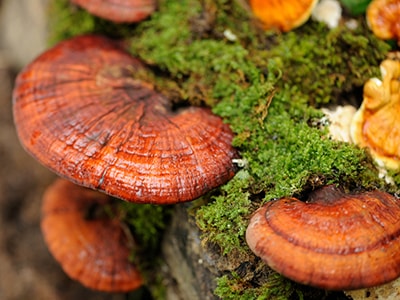

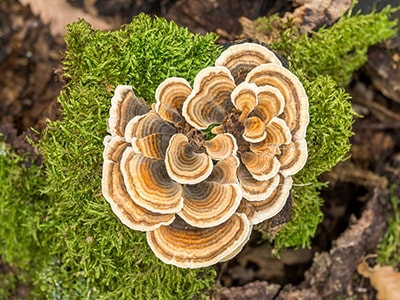

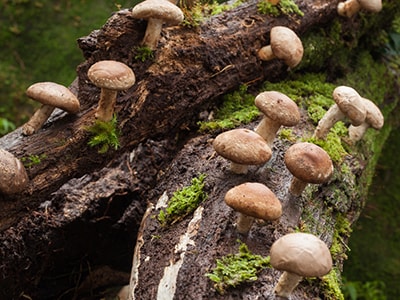
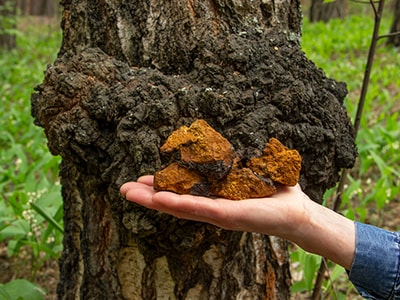
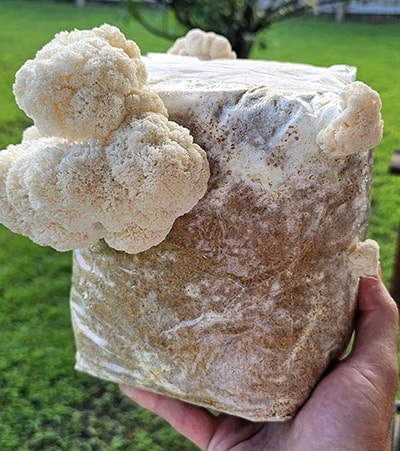
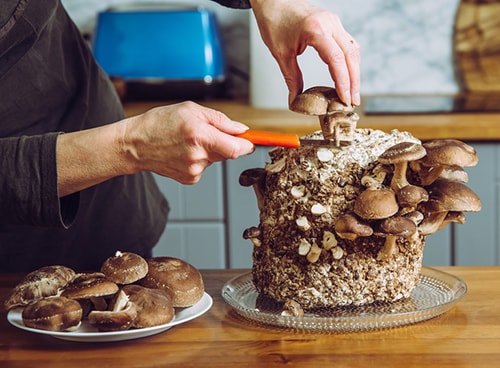
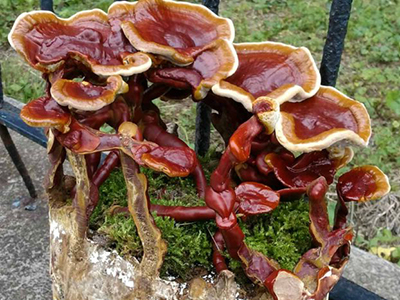

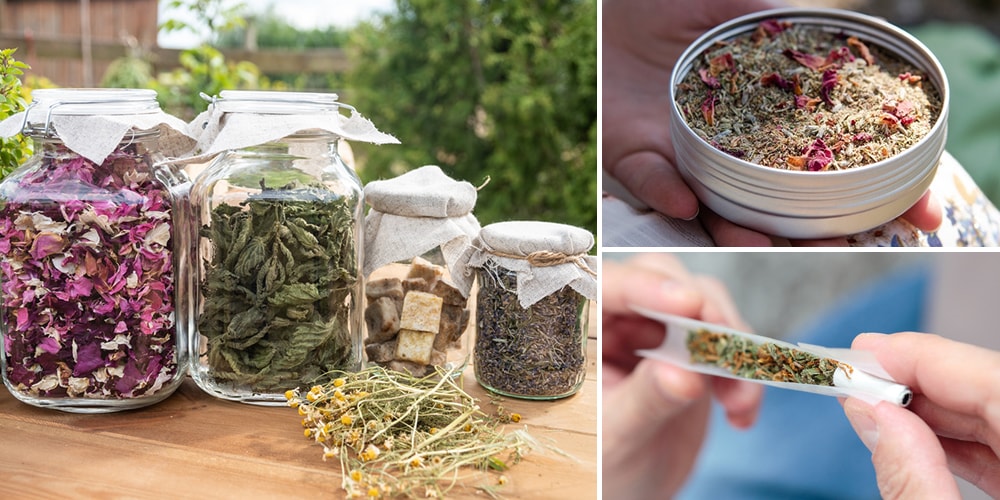
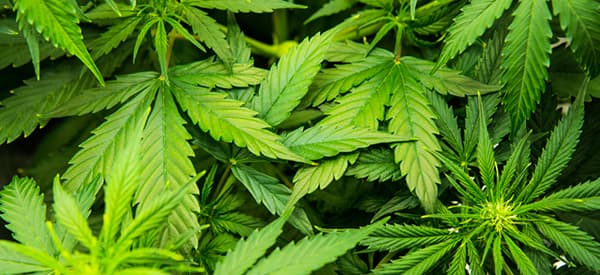
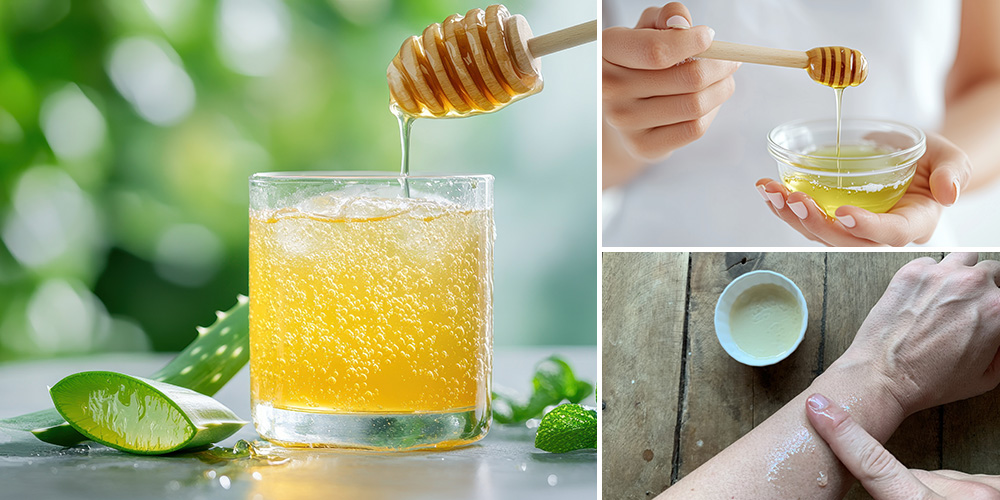
We have grown shiitake mushrooms in logs for a few years. The first time we used bulk spores with a plunger-type inoculator and we had lots of mushrooms from the same logs for several years. Then we bought the pre-loaded dowel plugs which didn’t produce nearly as much. We have tried growing them in buckets per YT videos without success. Before I would ever go to all the trouble of making my own medium described in this article, I would just buy the premade medium and drill out holes in hardwood logs. The plugged logs have to be coated in paraffin wax after plugging the holes with spore. Stand them up against a strong support in a shady area so that there will be growth all around the logs. It can take several months, even a year to get a supply, with more growth in the cooler humid months.
Hi Beth,
Thank you so much for taking the time to share all this with us.
We really appreciate it.
Many blessings and good health!